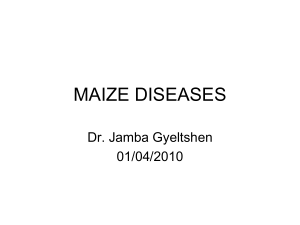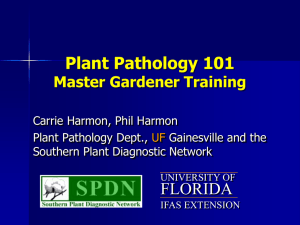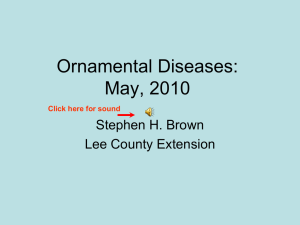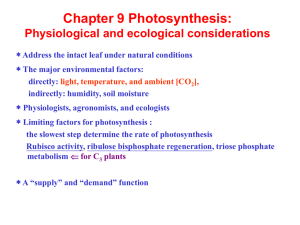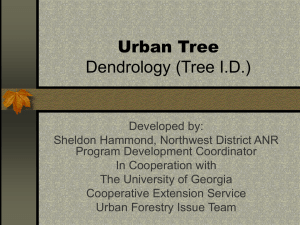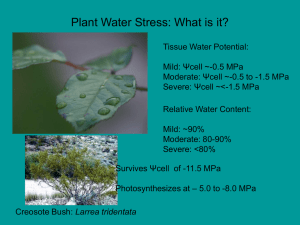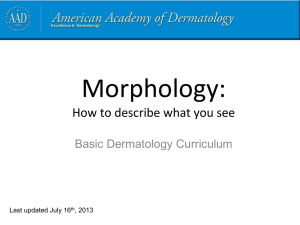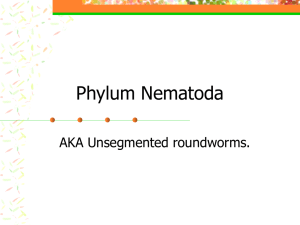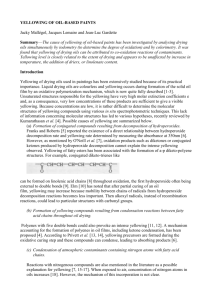Plant Disease
advertisement
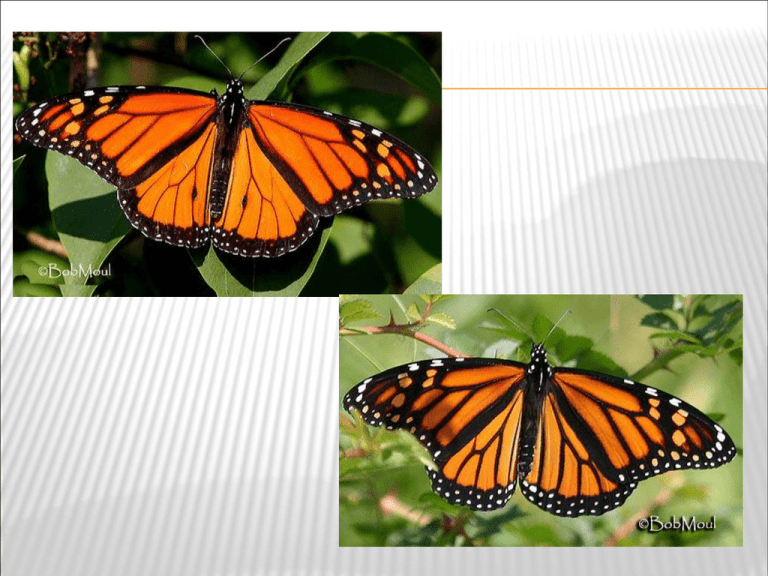
ADULT MALE & FEMALE LARVA AND PUPAE STAGE COMPLETE METAMORPHOSIS http://www.bing.com/videos/watch/video/monarch-butterfly-pupation/4CA8292A29F610D1DA5B4CA8292A29F610D1DA5B http://www.bing.com/videos/watch/video/monarch-butterfly-metamorphosis/242142B9588E878D68A9242142B9588E878D68A9 OTHER LARVAE/PUPAE http://bugguide.net/index.php?q=search&keys =caterpillars THE DISEASE TRIANGLE All factors present disease can result Methods of control can modify the triangle Susceptible Host Host No Disease No Disease No Disease Disease No Disease Pathogen No Disease No Disease Environment CAUSES OF PLANT DISEASES Biotic factors (biological in origin) Fungi Bacteria Viruses Nematodes Phytoplasmas Abiotic factors (non-biological) Weather Environmental pollutants PLANT DISEASES: FUNGI Largest pathogen group Over 200,000 known species of fungi More than 8,000 cause plant diseases Reproduce by asexual and sexual means Spores are like seeds SIGNS OF FUNGAL DISEASES Powdery Mildew White coating on plant sprinkled Group Host with powdered sugar of diseases specific Environmental conditions correct (high humidity) SIGNS OF FUNGAL DISEASES Rust Rusty-orange powdery pustules Easily removed by rubbing leaf Can produce 4 types of different spores Alternate hosts (Cedar-apple rust fungus) SYMPTOMS OF FUNGAL DISEASES Symptom Spots Roughly circular NECROTIC (dead area) Lesions Abnormalities in a plant Give us a sense if fungus or other pathogen Irregular shaped spots Lesions can have yellow halos Blight Spots or lesions enlarge and merge Black Spot of Elm, Gnomonia ulmea Lesions Often delimited (bordered) by veins Angular appearance Fungal lesions more irregular shape Alternaria leaf blight caused by Alternaria solani (left) and Septoria leaf blight caused by Septoria lycopersici (right) Cankers Lesions on stems, branches or trunks Sunken Outer and discolored bark fallen away Rots Destruction and disintegration of a large portion of the plant Affected areas are discolored and soft Crown rots Root rots Southern blight Sclerotium rolfsii Fruit Rots Start as dry rots Secondary microorganisms (bacteria) begin and lead to soft, slimy rots Pytophthora fruit rot of pumpkin Wilts Indicate plant is not getting water Plants have a droopy appearance Root rots Root system decayed, no longer absorb water Cineraria with root rot Pythium Wilts Vascular wilt invades the xylem (water conducting tissue) Vascular discoloration or browning Xylem changes from whitish color to brown, green or gray color Verticillium Bacterial Wilt of Cucumber carried by Cucumber Beetle PLANT DISEASES: BACTERIA Second most important group of plant pathogens Spots Lesions Blight Rots Vascular Galls wilts Galls Bacterial infections can cause galls to form Bacterium induces gall formation by injecting it’s own DNA into a plant cell Crown gall PLANT DISEASES: VIRUSES Reproduce by taking over host reproductive machinery Often associated with insect vectors Reproduction can take place in vector Can be transmitted mechanically Grower handling issues Plants rubbing together SYMPTOMS OF VIRAL DISEASES Mosaic Mottling Leaf and Fruit Distortions Ringspot Mosaic Classic symptom Blotchy light and dark green coloring on leaves Poinsettia mosaic virus Rose Mosaic Virus Interesting lines and patterns Mottle Blotchy coloring occurs on flowers of other colored flower parts ECONOMIC IMPORTANCE Some cases of viral infections can be highly desirable Tulips Leaf and Fruit Distortions Leaves are narrow or “strappy”, thicker then normal Leaves are curled and twisted Fruit has warts (yellow raised bumps) Zucchini Ringspot Concentric ring patterns on fruit or leaves Papaya ringspot PLANT DISEASES: PHYTOPLASMAS Odd bacteria like organisms Much smaller than bacteria, need an electron microscope Transmitted by insects usually leafhoppers Leafhoppers are phloem feeders SYMPTOMS OF PHYTOPLASMA DISEASES Virescence Brooming Fasciation Twisting and Distortion Virescense Normally colored plant parts are green Brooming Plant parts become overly branched and bushy Brooming - Ash Yellows Fasciation Flattening Maple branch of plant parts Twisting, Distortion and Virescence Cosmos with Aster Yellows PLANT DISEASES: NEMATODES Parasitic worms Very complex compared to other pathogens Usually seen only with a light microscope Reproduce by eggs Nematodes Identified by extracting from soil or infected plant material Non-pathogenic vs. pathogenic nematodes Pathogenic have a stylet Modified tissue tooth that punctures and feeds on plant Gall formation by nematodes Nematode tunnels into the root It’s saliva stimulates plant root cells to divide PLANT DISEASES: ABIOTIC FACTORS Nutritional abnormalities Pesticide exposure Environmental pollutants Adverse weather conditions SYMPTOMS Abnormalities are called INJURIES Discolortion Yellowing Chlorosis Reddening TYPES OF NUTRIENT ABNORMALITIES PAGE 169 Yellowing at margins of leaf General yellowing lack of nitrogen Leaf veins remain green and leaf blades turn yellow lack of molybdenum lack of iron or manganese Reddening of foliage lack of phosphorus Molybdenum deficiency on poinsettia Yellowing at margins Pesticide exposure Curling and cupping Geranium exposed to the herbicide 2,4-D Pesticide exposure Twisting Tomatoes exposed to the herbicide 2,4-D Pesticide exposure Distortion Rose exposed to a phenoxy-type herbicide Symptoms similar to viruses and phytoplasmas Gather information Pesticide exposure Fungicide use can cause marginal burning Follow the label directions Environmental Pollutants Contaminants in water or the air Marginal bronzing on Shefflera due to exposure to sulfur dioxide Environmental Pollutants Lesions on Dracena from high levels of fluoride in water or fluoride gas Paper thin lesions, concentrated at margins Environmental Pollutants Browning of arborvitae due to dog urine Environmental Pollutants Cold injury Candles Gather starting to grow and cold weather comes information Environmental Pollutants Heat injury High temps can cause tissue damage Environmental Pollutants Adverse Winter weather conditions injury Air temps rise but soil temps are cold Plant begins growing but the roots can’t get water to the foliage Plant desiccates and dies Environmental Pollutants Adverse weather conditions Drought stress, reddening of branches WHERE TO GO FOR HELP… Plant Disease Diagnostics Clinic http://www.plantpath.wisc.edu/pddc/index.html Soil and Plant Analysis Lab Nutritional disorders http://uwlab.soils.wisc.edu/ Slides in power point are copy write: 1999 by the Board of Regents of the University of Wisconsin System doing business as the division of Cooperative Extension of the University of Wisconsin Extension
